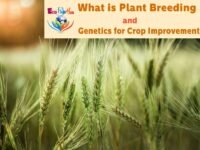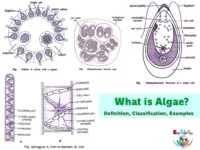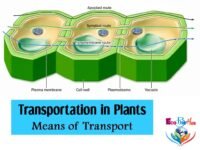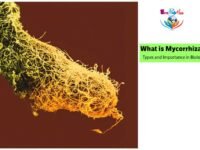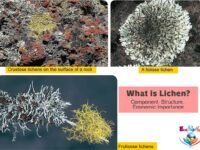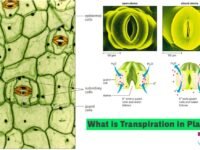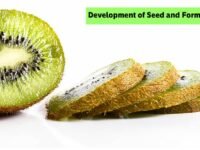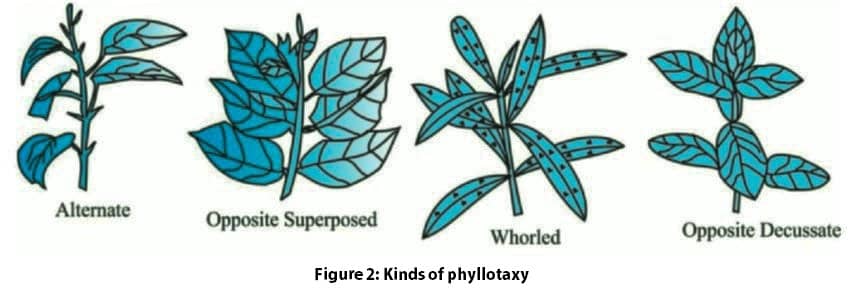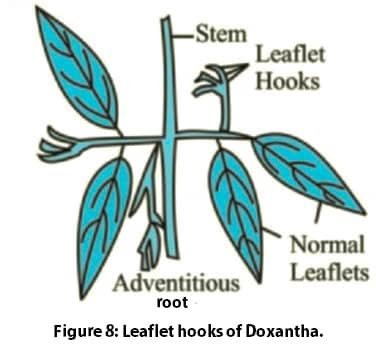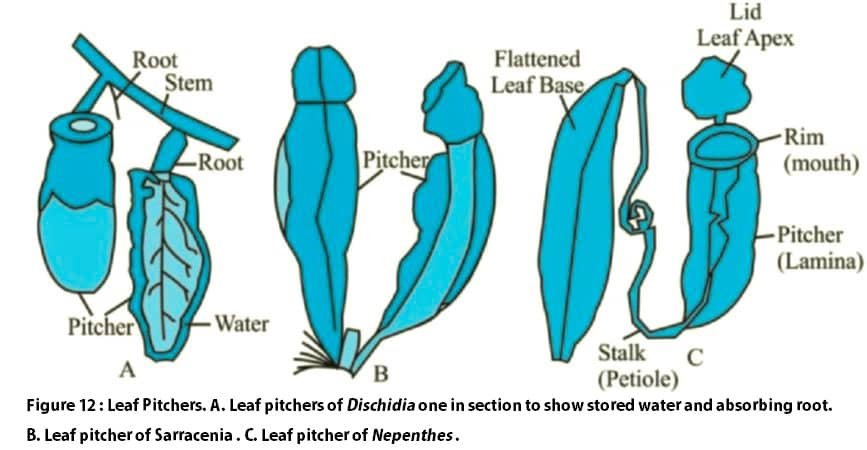In this tutorial, we described different parts of a leaf (especially a typical leaf) and the differentiation between simple leaf and compound leaf along with examples. Additionally, we described the phyllotaxy of leaves, different modifications of leaves, and the importance of the leaf morphology.
The leaf may be regarded as the flattened lateral outgrowth of the stem or the branch developing exogenously (i.e., from superficial tissues) from the node and having a bud in its axil. In this respect, the leaf is a partial stem or branch having limited growth. They are green in colour always follow an acropetal order of development and are exogenous in origin.
TABLE OF CONTENTS
PARTS OF A LEAF (TYPICAL)
A typical leaf consists of the following parts, each with its own function.
It is the part attached to the stem. In monocots, the leaf base commonly expands into a sheath which is partially or wholly clasps the stem, while in many dicots the leaf base bears two lateral outgrowths known as the stipules. In legumes and other plants, the leaf base is swollen and is called a pulvinus.
(02) Leaf stalk (or Petiole)
It is the stalk of the leaf. When the petiole is absent the leaf is said to be sessile, when present it is said to be petiolated or stalked. But the petiole shows certain peculiarities.
● In water hyacinth, petiole swells into spongy bulb containing air chambers.
● In Citrus it is winged.
● In Australian acacia, the petiole is modified into a flat green structure called phyllode.
● In Clematis it is a tendril and in Smilax petiole is modified into tendrils.
(03) Leaf-blade (or Lamina)
The green flat expanded part of the leaf. It goes without saying that the blade is the most important part. The blade has usually a prominent rib running up to the tip. It is the midrib. The midrib has many branches and sub-branches distributed in the lamina. They are called veins. Veins really form the skeleton of the leaf on which softer materials remain inserted, and they are the channels for the conduction of water and food. The outer edge of the leaf forms the margin, and the extreme tip, the apex.
PHYLLOTAXY OF LEAVES
The leaves are not haphazardly arranged on the stems and branches but they come out in a definite order. This arrangement of leaves on the stems and branches is known as phyllotaxy, meaning leaf order. The main objective of phyllotaxy is to expose the leaves to proper illumination for different vital functions, avoiding shading as far as possible.
The leaves in this case are seen to be spirally arranged around the stem. If an imaginary spiral line be drawn from the base of one particular leaf and this line passes around the stem through the bases of the successive leaves. A single leaf arises at each node.
Example: China rose, Ipomoea, Mustard, Tobacco, Sunflower, etc.
(02) Opposite Phyllotaxy
The two leaves at each node are always opposite to one another. If the successive pairs of leaves are placed at right angles to one another. Such an arrangement of leaves is said to be the opposite decussate.
Example: Ixora, Ocimum, Calotropis.
In this case, when looked from the top all the leaves will be found to be arranged along four vertical rows. Sometimes, however, a pair of leaves is seen to stand directly over the lower pair on the same plane. Such an arrangement of leaves is said to be oppositely superposed. So all the leaves lie in one plane and when viewed from above, all the leaves are found to lie in two vertical rows.
Example: Quisqualis, Psidium, Carissa.
(03) Whorled or Verticellate Phyllotaxy
When there are more than two leaves at each node and these are arranged in a circle or whorl.
Example: Alstonia, Oleander, Allamanda, etc.
SIMPLE LEAF
A leaf having a single or undivided lamina is called a simple leaf. The lamina can have various types of incisions, which may reach up to half (-fid), more than half (-partite), or near the base of the midrib (-sect).
Depending upon the pinnate or palmate venation, the incisions are known as pinnatifid, palmatifid, pinnatipartite, palmatipartite, pinnatisect, and palmatisect
COMPOUND LEAF
A leaf is said to be compound when the incision of the leaf blade goes down to the mid-rib (rachis) or to the petiole. So that the leaf is broken up into a number of segments called leaflets, these being free from one another, not connected by any lamina, and more or less distinctly jointed at their base.
A bud (axillary bud) is present in the axil of a simple or compound leaf, but it is never present in the axil of the leaflet of a compound leaf.
■ Compound Leaf Examples
A compound leaf is of two types: (A) Pinnately Compound Leaf and (B) Palmately Compound Leaf
(01) Pinnately Compound Leaf
A pinnately compound leaf is defined as the one in which the midrib known as rachis bears laterally a number of leaflets (called pinnae) arranged in an opposite manner.
➢ Pinnately Compound Leaf Examples: Tamarind, Gram, Gold mohur, Acacia, Mimosa, etc.
 It may be of the following types:
It may be of the following types:
(i) Unipinnate: The leaf is divided only once in a pinnate fashion. The leaflets or pinnae are attached on an axis which is a continuation of the petiole. It is called the rachis. The leaflets are commonly borne in opposite or sub-opposite (e.g., Murraya) pairs.
The unipinnate leaves are of two types:
(a) Paripinnate: The leaflets of this unipinnate leaf are even in number e.g., Cassia fistula (vern. Amaltas), Sesbania, Tamarind (vern. Imli).
(b) Imparipinnate: The leaflets are odd in number with a terminal unpaired leaflet e.g., Rose, Murraya
(ii) Bipinnate: Here the pinnate leaf is divided twice pinnately. The leaflets called pinnules are borne on the secondary axes known as rachillae or rachules. The rachillae are arranged in a pinnate fashion on the Primary axis or rachis, e.g., Acacia nilotica (vern. Kikar), Mimosa pudica (Touch me not Plant), Albizzia (Sirin, Siris).
(iii) Trip-innate: The leaf is thrice pinnate. The leaflets or pinnules are borne on tertiary axes e.g., Moringa (vern. Sahinjana, Soanjana), Oroxylum, etc.
(iv) Decompound: In this type, the leaf is more than thrice pinnate. e. g., Fennel, Coriander (vern. Dhania), Carrot (vern. Gaajar). In several such cases, the development of lamina is suppressed and the compound branches of the rachis remain green carrying on the function of photosynthesis. Example: Coriander, Carrot, Cosmos, Foeniculum, etc.
(02) Palmately Compound Leaf
The palmate compound leaf is one in which the petiole bears leaflets at the tip like the fingers of the palm. A joint may be present between the tip of the petiole and the leaflets.
➢ Palmately Compound Leaf Examples: Depending upon the number of the leaflets present, a palmate compound leaf may be of the following types:
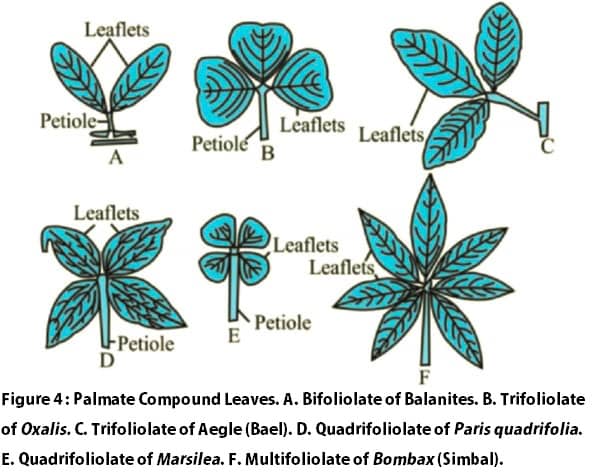 (i) Multifoliolate or Digitate: five or more leaflets, present at the tip of the petiole, (Figure F.) e.g., Bombax (Red Silk Cotton, vern. Simbal), Cleome.
(i) Multifoliolate or Digitate: five or more leaflets, present at the tip of the petiole, (Figure F.) e.g., Bombax (Red Silk Cotton, vern. Simbal), Cleome.
(ii) Quadrifoliolate or Quadrinate: four leaflets attached to the tip of the petiole, (Figure D) e.g., Paris quadrifolia; Marsilea also seems to have quadrifoliolate leaves (Figure E), although, in reality, its leaves are pinnately divided.
(iii) Trifoliolate or Ternate: three leaflets, (Fig В, C), e.g., Aegle marmelos (Wood Apple, vern. Bael), Butea (Dhak), Oxalis.
(iv) Bifoliolate or Binate: two leaflets, attached side by side at the tip of petiole (Figure A), e.g., Balanites, Hardwickia.
(v) Unifoliolate: a single leaflet separated from the petiole by a constriction e.g., Citrus (Figure 5). The leaf of citrus appears to be a simple leaf with an undivided lamina and winged petiole. However, it has a joint or constriction between the lamina and the petiole of the leaf. The close relatives of Citrus possess trifoliolate leaves (Aegle marmelos, Figure 4.C). Even in Citrus, many abnormal leaves bear two small leaflets just on the sides of the normal blade (Figure 5. B). This clearly shows that the leaf of Citrus is, in reality, a palmate compound leaf where the two lateral leaflets have been suppressed and only the central leaflet (the normal blade) is functional. Such a palmate compound leaf, with one functional leaflet, is called a unifoliolate compound leaf.
MODIFICATIONS OF LEAF
Some of the important types of modification of leaves are listed below:
(01) Leaf Tendrils
Tendrils are thread-like sensitive structures that can coil around support to help the plant in climbing. Leaf tendrils are usually un-branched and devoid of scales. They are of the following types (Figure 6):
 (i) Whole Leaf Tendrils: In Wild Pea (Lathyrus aphaca, Figure 6 A) the whole leaf is modified into a tendril for climbing. The stipules become foliaceous to perform the function of photosynthesis. An axillary bud is found in the axil of the tendril.
(i) Whole Leaf Tendrils: In Wild Pea (Lathyrus aphaca, Figure 6 A) the whole leaf is modified into a tendril for climbing. The stipules become foliaceous to perform the function of photosynthesis. An axillary bud is found in the axil of the tendril.
(ii) Leaflet Tendrils: A few upper leaflets of the pinnate compound leaves of Pea (Pisum sativum, Figure 6 B) and Sweet Pea (Lathyrus odoratus) are transformed into tendrils while the rest are normal.
(iii) Petiolar Tendrils: The petioles of Garden Nasturtium (Tropaeolum majus, Figure 6 C) and Nepenthes (Figure 6 D) are elongated, sensitive, and capable of coiling around the support like the tendrils.
(iv) Rachis and Petiolule Tendrils: The petiole, rachis and the stalks of the leaflets (petiolules) in Clematis (Figure 6 E) are sensitive to contact and can coil around the support to help the plant in climbing.
(v) Rachis Tip Tendrils: In Lentil, (Lens culinaris, vern. Masur) the tip of the rachis is transformed into a tendril.
(vi) Leaf Tip Tendrils: The leaf apices of Gloriosa superba (vern. Kulhan or Kalihan; Glory Lily, Figure 6 F) are greatly elongated to function like the tendrils.
(vii) Stipular Tendrils: They are found in Smilax at the free ends of adnate stipules (Figure 6 G).
(02) Leaf Spines
 The leaf parts become changed into spines in order to protect the plant from grazing animals and excessive transpiration. Prickles occur at various positions (margins, apex, surface) on the leaves for the same purpose, e.g., Aloe, Solanum surattense (=S.xanthocarpum), Carthamus oxycantha.
The leaf parts become changed into spines in order to protect the plant from grazing animals and excessive transpiration. Prickles occur at various positions (margins, apex, surface) on the leaves for the same purpose, e.g., Aloe, Solanum surattense (=S.xanthocarpum), Carthamus oxycantha.
In Barberry, the leaves of the main stem are modified into branched 3-5 rayed spines. Dwarf branches arise in their axils (Figure 7 A). The spines present on the areoles of Opuntia also represent the leaves. Leaf spines also occur in other cacti (Figure 7.B) and the climbing varieties of Asparagus. Spines of Zizyphus and Acacia are modified stipules.
(03) Leaflet Hooks
In Doxantha (Bignonia unguiscati) the terminal leaflets of the compound leave become transformed into three stiff claw-like and curved hooks (Figure 8). They resemble the nails of a cat and hence the names of the plant, the hooks cling to the bark of the supporting tree very firmly and allow the plant to climb up.
(04) Phyllodes (Phyllodia)
In several species of Acacia found in the deserts of Australia (e.g., A. longifolia, A. glaucescens, A. recurva, A. auriculiformis), the bipinnate lamina is absent. Instead, the petiole and part of the rachis become flattened into sickle-shaped structures for performing the function of food synthesis (Figure 9). Such a flattened petiole that carries out the functions of the lamina is called phyllode.
The formation of phyllode is a mechanism to reduce transpiration because:
(i) It is vertically placed and
(ii) Has fewer stomata.
In Parkinsonia aculeata, the rachis ends in a spine. Rachis branches (= secondary rachis) are elongated, flattened and green to function as phyllodes (Figure 10). They bear small leaflets which fall off very early.
(05) Leaf Bladders
They occur in the aquatic carnivorous plants of Utricularia (Bladderwort). Some of the leaf segments are modified to form small bladders (1-3 mm in diameter). A bladder has sensitive hair, branched trigger bristles, a trap valve, internal and external glands for trapping and digesting small animals (e.g., Water Fleas) (Figure 11).
(06) Leaf Pitchers
The leaf or lamina is modified to form a large pitcher (Figure 12) in Dischidia, Nepenthes, and Sarracenia. In epiphytic Dischidia the whole leaf is changed into an open pitcher for storing rainwater. The same is absorbed throughout the year by adventitious roots (= nest roots).
In Nepenthes and Sarracenia, the pitchers are meant for catching and digesting insects. The lamina is modified into a pitcher. The leaf apex gives rise to a coloured lid for attracting insects. In Nepenthes, the leaf base is foliaceous while the leaf stalk is tendrillar. The rim of the pitcher has nectariferous glands. The interior of the pitcher is slippery. The base is filled up with digestive fluid.
(07) Succulent Leaves
The leaves are fleshy or swollen. They store water, mucilage, or food materials. Succulent leaves occur in plants of saline and xerophytic habitats, e.g., Aloe, Agave, Bryophyllum, Portulaca. In bulbs, the fleshy scales are actually the leaf bases, e.g., Onion.
(08) Scale Leaves
They are whitish or brownish, small, dry, and membranous leaves that do not take part in photosynthesis. Photosynthesis is performed by green stems, e.g., Casuarina, Ruscus.
(09) Coloured Leaves
In Poinsettia (= Euphorbia pulcherrima, vern. Lai Patti), the leaves borne near the cyathia are brightly coloured to attract insects for pollination.
(10) Floral Organs
Floral organs are specialized leaves sepals, petals, stamens, and carpels. Sepals are protective and green, petals are coloured and attractive, and stamens are pollen-bearing structures or microsporophylls while carpels are ovule-bearing megasporophylls.
IMPORTANCE OF LEAF MORPHOLOGY
1. Leaf morphology is employed in taxonomy for accurate description, identification, and classification of plants. For this, the leaves show specific variations in shape, apex, base, margin, phyllotaxy, venation, etc.
2. Crop productivity is determined by the rate of leaf production, periods for which they are retained on the plants, their orientation to light, shape, area, etc.
3. Some plants show developmental heterophylly. In such plants shape of the leaves indicates the stage of plant maturity, e.g., Gossipium, Eucalyptus.
4. Any peculiarity of shape, size, and colour including variegation of leaves is picked up by horticulturists for propagation.
5. Foliage plants are grown for adorning our verandahs and passages.
6. The foliage of some plants is economically important, e.g., Tea, Betel, Mint, Thyme, Oregano, etc.

